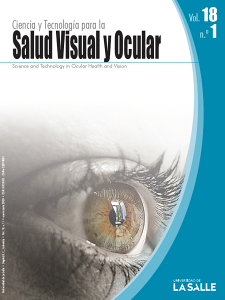Abstract
Noxious effects of sun radiation on the skin and the eye surface are widely known. However, the photochemical damage to the retina is still under research. It has been documented that even a short time, either a recurring or one-time, exposure to radiation can induce histological changes affecting the quality of vision, from transitory disturbances to irreversible maculopathy. In spite of it, there is limited information on the prevalence and incidence of events related to either environmental or occupational light exposure. This research aims to identify the etiology and factors associated with acquired retinal phototoxicity and the research methodology used was a secondary-source review. As a result, it was found that free radical release due to direct exposure to a light stimulus may cause irreversible damages in the photoreceptors and, consequently, may cause a reduction in the visual acuity and anomalies in the color perception. As a conclusion, sun exposure has been clearly described in the scientific literature as a factor associated with retinal phototoxicity. However, even though some ophthalmologic clinical practices and surgical procedures are known to induce toxic lesions due to the free radical release in the retina, there is scarce referencing on this topicReferences
Sliney DH. What is light? The visible spectrum and beyond. Eye (Lond). 2016;30(2):222-9. DOI: 10.1038/eye.2015.252
Modenese A, Korpinen L, Gobba F. Solar Radiation Exposure and Outdoor Work: An Underestimated Occupational Risk. International journal of environmental research and public health 2018;15(10):2063. DOI: 10.3390/ijerph15102063
Youssef PN, Sheibani N, Albert DM. Retinal light toxicity. Eye 2011;25(1):1-14
International Commission on Non-Ionizing Radiation Protection. ICNIRP statement—protection of workers against ultraviolet radiation. Health Phys. 2010 Jul;99(1):66-87. DOI: 10.1097/HP.0b013e3181d85908
Dhananjay Shukla. Tomografía de coherencia óptica y hallazgos de autofluorescencia en maculopatía fototóxica crónica secundaria a radiación solar reflejada en la nieve
Rocha Cabrera P, Cordovés Dorta L, González Hernández M. Bilateral solar retinopathy. Autofluorescence and optical coherence tomography. Archives of the Spanish Society for Ophthalmology (Archivos de la Sociedad Española de Oftalmología, English Edition). 2016;91(8):391-6
Dayhaw-Barker P. Retinal pigment epithelium melanin and ocular toxicity. Int J Toxicol. 2002;21(6):451-4. DOI: 10.1080/10915810290169873
Rai N, Thuladar L, Brandt F, Arden GB, Berninger T. Solar retinopathy. Doc Ophthalmol. 1998r;95(2):99-108
Källmark FP, Ygge J. Photo-induced foveal injury after viewing a solar eclipse. Acta ophthalmologica Scandinavica. 2005;83(5):586-9. DOI: 10.1111/j.1600-0420.2005.00511.x
Van Norren D, Gorgels, T. G. The action spectrum of photochemical damage to the retina: a review of monochromatic threshold data. Photochem Photobiol. 2011;87(4):747-53. DOI: 10.1111/j.1751-1097.2011.00921.x
Hunter JJ, Morgan JI, Merigan WH, Sliney DH, Sparrow JR, Williams DR. The susceptibility of the retina to photochemical damage from visible light. Prog Retin Eye Res. 2012;31(1):28-42. DOI: 10.1016/j.preteyeres.2011.11.001
van de Kraats J, van Norren D. Optical density of the aging human ocular media in the visible and the UV. J Opt Soc Am A Opt Image Sci Vis. 2007;24(7):1842-57. DOI: 10.1364/josaa.24.001842
Sliney DH. How light reaches the eye and its components. Int J Toxicol. 2002;21(6):501-509. doi:10.1080/10915810290169927
Glickman RD. Phototoxicity to the Retina: Mechanisms of Damage. Int J Toxicol. 2002;21(6):473-90. DOI: 10.1080/10915810290169909
Stockman A, Sharpe LT, Fach C. The spectral sensitivity of the human short-wavelength sensitive cones derived from thresholds and color matches. Vision Res. 1999;39(17):2901-27. DOI: 10.1016/s0042-6989(98)00225-9
Fisher GJ, Wang Z, Datta SC, Varani J, Kang S, Voorhees JJ. Pathophysiology of premature skin aging induced by ultraviolet light. N Engl J Med. 1997 Nov 13;337(20):1419-28. doi: 10.1056/NEJM199711133372003
Pearse AD, Gaskell SA, Marks R. Epidermal changes in human skin following irradiation with either UVB or UVA. Journal of Investigative Dermatology. 1987;88(1):83-7
Sample PA, Esterson FD, Weinreb RN, Boynton RM. The aging lens: in vivo assessment of light absorption in 84 human eyes. Invest Ophthalmol Vis Sci. 1988;29(8):1306-11
Zhou H, Zhang H, Yu A, Xie J. Association between sunlight exposure and risk of age-related macular degeneration: a meta-analysis. BMC Ophthalmol. 2018;18(1):331. DOI: 10.1186/s12886-018-1004-y
Krigel A, Berdugo M, Picard E, Levy-Boukris R, Jaadane I, Jonet L, et al. Light-induced retinal damage using different light sources, protocols and rat strains reveals LED phototoxicity. Neuroscience. 2016;339(17):296-307. DOI: 10.1016/j.neuroscience.2016.10.015
Paskowitz DM, LaVail MM, Duncan JL. Light and inherited retinal degeneration. Br J Ophthalmol. 2006;90(8):1060-6. DOI: 10.1136/bjo.2006.097436
Sliney DH. Exposure geometry and spectral environment determine photobiological effects on the human eye. Photochem Photobiol. 2005;81(3):483-9. DOI: 10.1562/2005-02-14-RA-439
Tenkate TD. Ocular ultraviolet radiation exposure of welders. Scandinavian Journal of Work, Environment & Health. 2017;43(3):287-8
Zagers NPA, van Norren D. Absorption of the eye lens and macular pigment derived from the reflectance of cone photoreceptors. Opt. Soc. Am. A. 2004;21(12):2257-68
Pareja-Esteban J, Bolívar de Miguel G, Dapena-Sevilla I, Drake-Casanova P, Castro-Rebollo M, Clement-Corral M. Retinopatía por eclipse: a propósito de tres casos. Arch Soc Esp Oftalmol. 2007;82(9):575-8
Harada T, Koizumi E, Saito A, Sugita K, Hisada H, Awaya S. Three cases with light-induced retinopathy. Doc. Ophthalmol. 1988;69(1):11-8
Albert DM. Principles and practice of ophthalmology. Philadelphia: Saunders; 1994
Yannuzzi LA, Fisher YL, Slakter JS, Krueger A. Solar retinopathy. A photobiologic and geophysical analysis. Retina. 1989;9(1):28-43. PMID: 2717802
Kleinmann G, Hoffman P, Schechtman E, Pollack A. Microscope-induced retinal phototoxicity in cataract surgery of short duration. Ophthalmology. 2002;109(2):334-8. doi: 10.1016/s0161-6420(01)00924-1
Vaughan DK, Peachey NS, Richards MJ, Buchan B, Fliesler SJ. Light-induced exacerbation of retinal degeneration in a rat model of Smith-Lemli-Opitz syndrome. Exp Eye Res. 2006;82(3):496-504. DOI: 10.1016/j.exer.2005.08.008
DePry J, DO, Brescoll J, Szczotka-Flynn, Loretta, OD, PhD, Rambhatla P, MD, Lim HW, MD, Cooper K, MD. Phototherapy-related ophthalmologic disorders. Clin Dermatol. 2015;33(2):47-255. DOI: 10.1016/j.clindermatol.2014.10.017
Stock RA, Savaris SL, de Lima Filho EC, Bonamigo EL. Solar retinopathy without abnormal exposure: case report. Arq Bras Oftalmol. 2013;76(2):118-20. DOI: 10.1590/s0004-27492013000200012
Bova LM, Sweeney MHJ, Jamie JF, Truscott RJ. Major changes in human ocular UV protection with age. Invest Ophthalmol Vis Sci. 2001 Jan;42(1):200-5. PMID: 11133868
Roberts JE. Screening for ocular phototocity. New York, USA: Department of Natural Sciences, Fordham University; 2018
